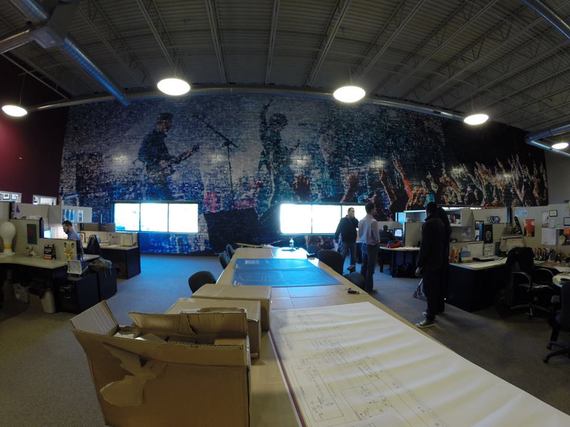A debate between Generation X and Generation Y notwithstanding, there is an ongoing discussion about the influence of workplace culture and productivity. Google, Microsoft and countless other office environments have shown that an investment in employee culture is an investment in productivity. These investments may look superficial at first glance, but when looking deeper, they are seen as ancillary perks as a result of corporate conviction, one that defines the meaning and intention behind each employee, and works to fulfill that sense of meaning sought by every millennial and appreciated by Generation X.
Meaning:
The importance of working on something that matters should be a given, but for millennials it's a staple. According to a recent study, the number one factor that young adults, ages 21 to 31, wanted in a successful career was a sense of meaning. One of the key features in "meaning" is a sense of belonging to a larger cause, where the person can be a giver in the service of something greater than themselves. The culture of a company is imperative when confronting this issue, and stands as the language by which corporate intent is communicated.
Example: DigitalRelevance
At my workplace, we put the right content out there for the right prospects at the right time. In doing so, we organically drive real conversion. We work nights, weekends and, even sometimes, holidays to do the job better than anyone. What is the source of this drive? What causes such commitment? The answer is an environment that aligns, cultivates and encourages innovation in such a way that aligns with the employee. What we do matters to us, and to each other. Additionally, we are constantly encouraged to venture beyond "assignments," and explore solutions for ourselves and our clients. We are encouraged to explore and foster our personal interests by having Friday's off and extended vacation time. The result is a passion that creates problem-solving, engaging content that drives real, long-term conversions.
The Blend of Work and Play:
No person can be at 100 percent all the time. Days spent working with two breaks, and sucking it up, are over, and rightly so. Everyone needs time to recuperate. Basketball courts, in-house gyms and billiard rooms are just a few examples of how companies are investing in their staff's well-being. As said before, these are not ancillary perks, but actionable investments in the employee. Creating an environment that encourages the individual to be themselves inherently strengthens the creative drive. Ideas and conversations surrounding a game of pool, or a bout on the basketball court, carry over into action with the customer as the beneficiary.
Example: PERQ
PERQ believes in their value of incentives-based conversion so deeply, that they apply it to their culture. Below is a picture of a wall mural comprised of 1,500 employee Instagram photos.
The mural is a tribute to all those that helped get PERQ to where they are, and will lead them in where they are going. As illustrated by their Facebook, other aspects in their culture further this intention, communicating that work and fun not only go hand-in-hand, but should be an integral part of everyday life. Everything within its culture has meaning. This philosophy inherently spills into their client relationships with over four million people reached resulting in high conversion rates and customer loyalty.
Collaboration:
Long gone are days of office collaboration being defined as "talking with someone at the water cooler." The work environments mentioned above showcase how all aspects of business, both serious and less serious, affect creative outcomes. The flow of information has changed the way business works, inherently requiring collaboration in order to compensate for missed data and differing interests. What may interest one of my co-workers may not interest me, but when I need a question answered regarding that subject, I go to them. In the case of client projects, we are made to be experts in everything we do. This instills a sense of confidence, dependency and innovation with each other as we learn more through each process. Collaboration has become something more than just teamwork, it has become a way of life. Foster an environment that minimizes (and solves) conflict, and encourages such collaboration to improve employee retention, while invoking a sense of meaning.
Example: Google
Yes, this is an obvious example, but still one of the best. On the employee's first day, their manager greets them at the door and says: "Hi, nice to meet you, you're on my team. We're gonna be working together, and doing a few other things." This has been proven to lead to a 15 percent increase in productivity in the short term, and a lasting first-impression forever. The person, in this case, immediately belongs to something, is shown that they matter and knows immediately with whom they will be working. This encourages collaboration, while incorporating the ever-important "meaning" in their everyday work. The blend of work and play is incorporated in the rest of Google's culture, from free meals and nap pods, to gym memberships and subsidized massages.
Aside from all the frills and conceptual theory, here's the real question: "Do investments in employee culture affect ROI?" In October of this year, Google gained $40 billion in market share in one day, with a 36 percent increase in net income for the third quarter of 2013. These gains are the result of attracting the best and brightest to an environment that nurtures innovation. So, the answer is a resounding YES.
In today's workplace, the need to invest in culture is paramount. These investments have a direct effect on productivity, loyalty and drive. More importantly, the sense of purpose is communicated, promoting collaboration and a mentality that is relaxed enough to be creative and serious enough to not only achieve objectives, but to surpass them.

